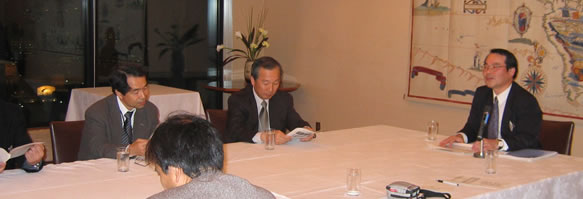 |
The last presentation
|
Cat:ICTPub:2006#:0606a |
Kanzo Kobayashi |
06316u/18215r |
Title
The
last presentation for NEC Soft Ltd.
NECソフト向け最後のプレゼンテーション
Index
- Globalism in the Information Age:
- Index:
- My career and background:
- What is global?:
- Various universes:
- Diachronic (historical) viewpoint:
- ynchronic viewpoint:
- Recent network theory:
- Value of network:
- Clash of the civilizations:
- GINI index:
- Fundamentals of nine countries:
- Relative comparison of nine countries:
- Ratio of youth population:
- Global adaptability:
- Linux market share:
- Distorted map:
Why?
- I have been happy to have job opportunity in Itochu and NEC Soft,
the former taught me what is global and the latter gave me deep
involvement in IT industry.
- I'd be appreciated to have such opportunity as my last presentation
today, summarizing the essence gained during 35 years at Itochu
and two & a quarter year at NEC Soft.
- Thank you friends and colleagues. I recollect the phrase that
"old soldiers never die, just fade away."
- 伊藤忠商事とNECソフトに仕事を得られたことを幸運に思う。前者はグローバルとは何かを教えてくれ後者はIT産業に深く関与させてくれた。
- このように今日、小生の最後のプレゼンの機会を与えてくれたことを感謝したい。お陰で伊藤忠での35年間およびNECソフトでの2年3ヶ月のエッセンスをまとめることができた。
- 友人と同僚に感謝したい。「老兵は死なず、只消えゆくのみ」という言葉を思い出す。
Presentation
Message
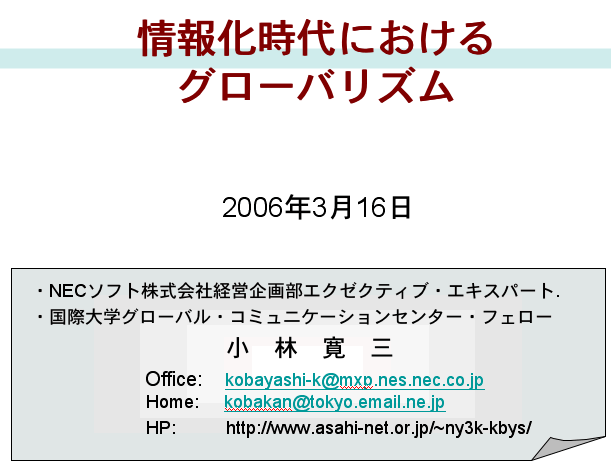
>Top 0.
Globalism in the Information Age:
- The theme "Globalism in the information age" is a contemporary
issue.
- I learned globalism mainly through 35-year Itochu life, and the
Information age I cultivated through 2-year & more NEC Soft
life.
- I appreciate friends and colleagues of Itochu and NEC Soft to
spare the time for my presentation. I'd like summarize the essence
got through the both companies as the farewell presentation.
- The continued stories will appear in this homepage. Your visit
here will be mostly appreciated.
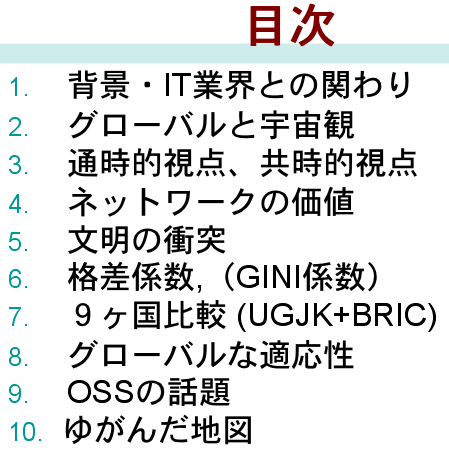
>Top 1.
Index:
- Here is today's index. All these issues are related to 'globalism'
and 'feature of network'.My career and background, and relation to the IT industry through
Itochu, Itochu-NTT affiliate, and NEC Soft.
- There are several outlooks of universe throughout history.
- Diachronic (historical) viewpoint, and synchronic viewpoint
- Value of network
- Clash of the civilization
- GINI index
- Comparison of 9 countries
- Global adaptability
- Topics of OSS
- Distorted map
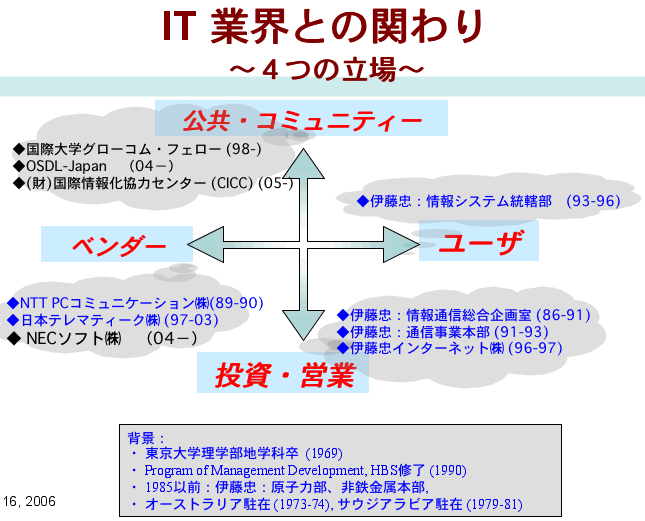
>Top 2. My career and background:
- Since 1986, one year after the year of deregulation of Japanese
Telecom Business law and privatization of NTT, I could have happily
experienced various relationship with rapidly changing IT industry:
- as a investor or a trader at Itochu business or development div.,
- as a user at Itochu MIS Div.,
- as vendors at NTT/Itochu affiliate companies and the present NEC
Soft,
- and also have been involved in the IT community and public organization.
- also I experienced twice overseas life at Australia and Saudi
Arabia as expatriate of Itochu.
- In my eyes many scenes of success and unsuccess came and went.
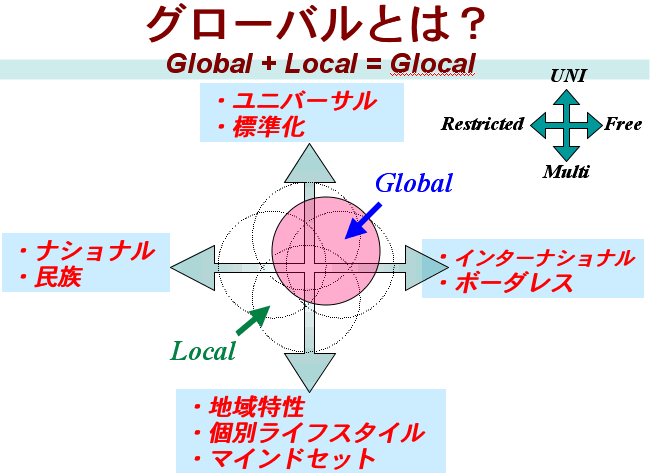
>Top 3.
What is global?:
- There are two axes to understand 'global.'
- Y-axis is weather it is UNI or MULTI. Globalism is aimed to be
universal like global standard. ('universe' means 'one'+'whole')
- The opposite concept is individual or local as individual life
style or mindset, or each personality.
- X-axis means, a bit differently, weather it is restricted or free
(open). Independence or self-driven is one of the most important
value of a nation.
- The opposite idea is recent trend of internationalism or borderless
situation. The flow of people, money, goods, and information are
getting free and borderless.
- Thus globalism has two concept of universalism and borderlessness.
- On the other hand localism appears in various nations and local
communities.
- 'Glocal' is a new concept of glocal and local as synthesis.
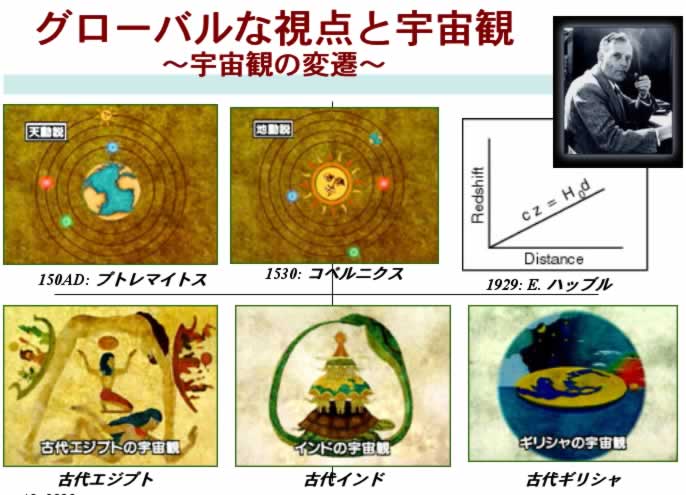
>Top 4. Various universes:
- Globe means the earth. There are historical transition of outlook
of the the earth, or universe.
- Ancient Egyptian believed the sun-god (Ra) comes out on a boat
with the sun from the death world (underworld) every morning along
the celestial Nile river.
- Ancient Indian believed that the world is supported by the back
of three big elephants, which are on a gigantic tortoise. Also this
tortoise is surrounded by a gigantic snake which bites its own tail.
- Ancient Greek believed the world is flat and surrounded by a big
ocean. This ocean is also surrounded by tall wall which composes
celestial sphere.
- In 150 AD, Ptolemaios described the model of universe system (Ptolemaic
system). The earth is the center of the universe, and all other
celestial bodies revolve around it. (Geocentric model)
- In 1530 Copernican revolution: discovered the planets orbits the
sun. But he thought the stars are only background attached to the
celestial sphere.
- In 1929 Edwin Hubble argued expansion of the universe.
- Thus, viewpoint of globalism or universe varies according to the
knowledge of human beings. In other words, there will be layers
of concept of universe, and we recognize the intellectual humility.
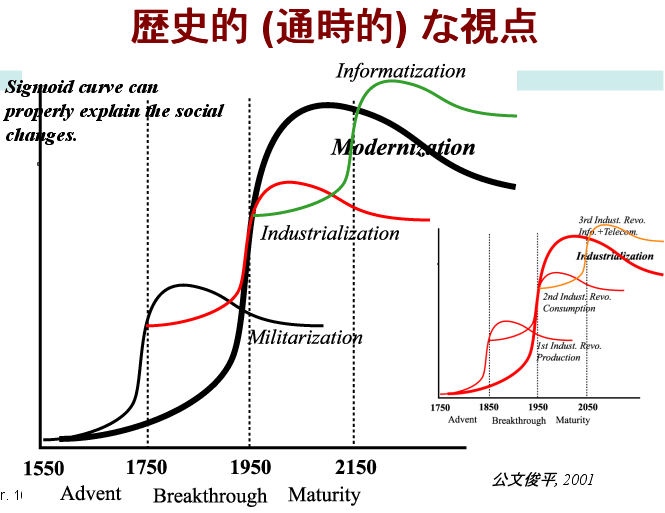
>Top 5.
Diachronic (historical) viewpoint:
- This schematic viewpoint is proposed by Prof. Kumon of Glocom
of IUJ.
- Modernization from 1550 can be described as a S-shaped curve
with three smaller S-curves with the interval of 200 years. This
seems to compose a fractal structure. The overlapped portion shows
concurrent period of mature stage of the former S-curve and advent
of the next one.
- The present belongs to concurrent period of mature stage of Industrialization
(small red S-curve) and advent stage of Informatization (small green
S-curve)
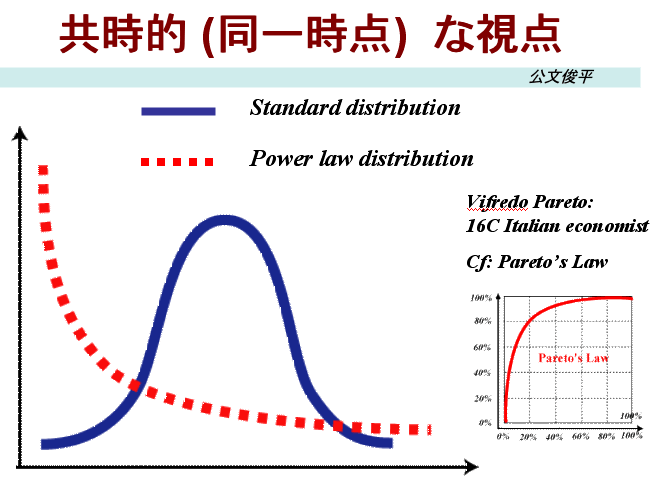
>Top 6.
Synchronic viewpoint:
- Bell-shaped (Normal) distribution has been long assumed as common
and natural distribution like the size of human beings, etc.
- But recently it has been noticed that various social phenomena
often shows power distribution beyond our expectations.
- Samples:
- Population of cities
- Popular movie film
- Popular travel destination
- Frequency of English words
- Access of popular blogs ....
- Clay Sirky points out that it may rather bring more unequality
as the result of increase of diversity and freedom of choice.
- In this universe where we live, power distribution could be comprehensive.
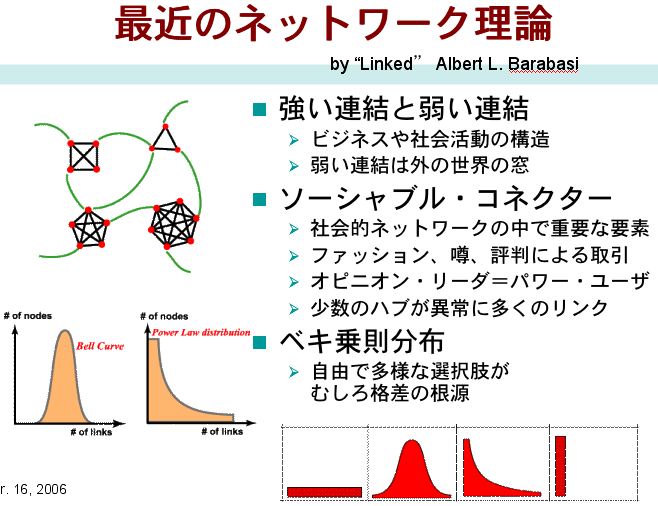
>Top 7.
Recent network theory:
- Strength of weak ties:
Our close friends are often friends with each other as well, fully
connected by strong ties (black line).
- But weak ties (green line) connect the members to their acquaintances.
Such weak ties play an important role in social activities from
spreading rumors to getting a job. (often called as opinion leaders,
power users)
- The bottom red graph shows a continuous change of distribution
(from right to left) perfect equality, standard distribution, power
law distribution, and perfect inequality (=monopoly).
- We, engineers, should know more about features of social network.
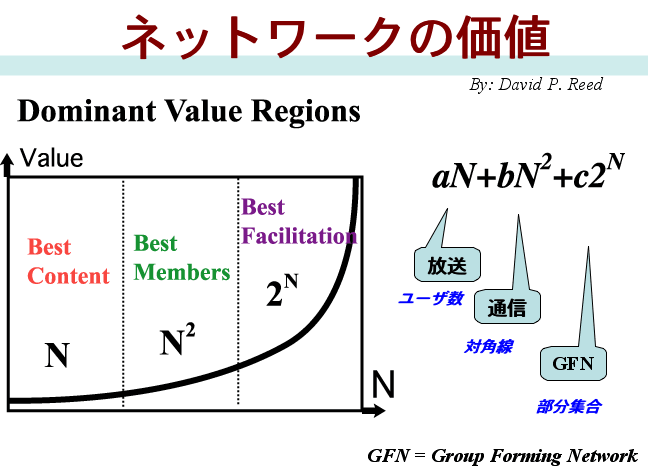
>Top 8. Value of network:
- Value of broadcast depends on the number of viewers. (N)
- Bob Metcalfe, inventor of Ethernet, states that the value of communication
network grow with square of the number of users. (N^2)
- Reed's law:
Network like the Internet, Group Forming Networks (GFN) enables
affiliations (such as interest groups, clubs, communities, chat)
among subsets of its customers.
- The number of subsets that can be formed from a set of N members
is 2^N - N - 1, which grows as 2^N. Thus potential number of groups
grows exponentially with N.
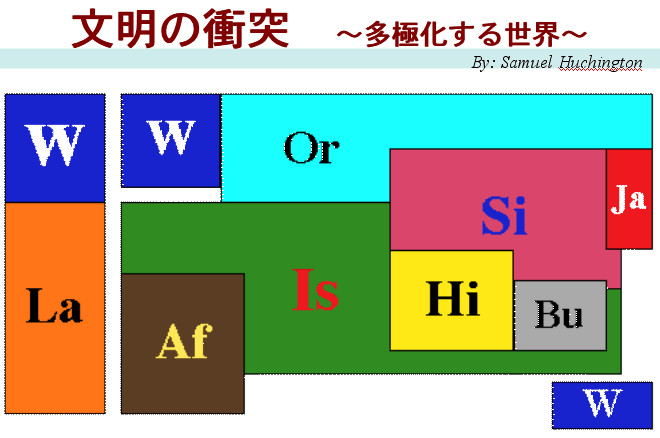
>Top 9. Clash of the civilizations:
- This is a simplified world map with major group of cultures.
- Samuel Huntington says that in the post Cold War world, the most
important distinctions among people are not ideological, political,
or economic. They are cultural.
- He also describes (in 1996, not now!) the image of world anarchy
with breakdown of governmental authority, ethnic or religious conflict,
emergence of international criminal mafias, refugees, proliferation
of nuclear or weapons of mass destruction, the spread of terrorism,
....
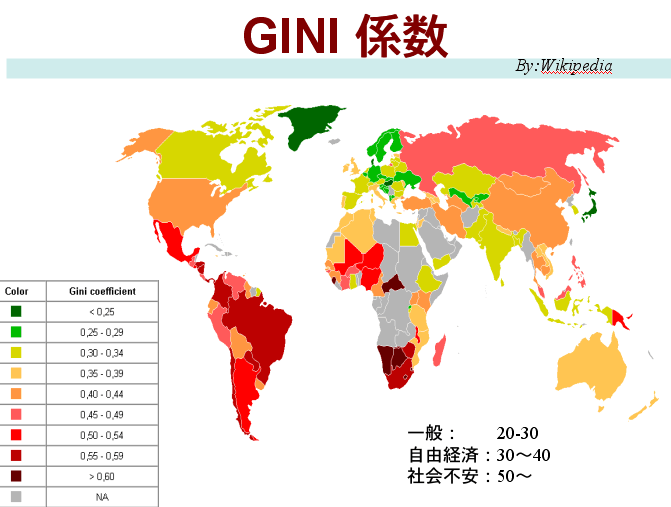
>Top 10. GINI index:
- GINI index is a measure of inequality developed by Italian statistician
Corrado Gini in 1912, where 0 corresponds with perfect equality
and 100 with perfect inequality.
- Generally GINI index ranges 20-30. But market mechanism tends
to increase GINI index around 30-40. It is said if this index exceeds
more than 50, social uncertainty grows.
- Most of European countries and Japan and Canada keep lower indices,
while former socialist countries show relatively higher indices.
(Socialist had pursued more equal society.)
- US is increasing rapidly GINI index.
- It need to study more the relationship of GINI index between effectiveness
of social politics and market mechanism.
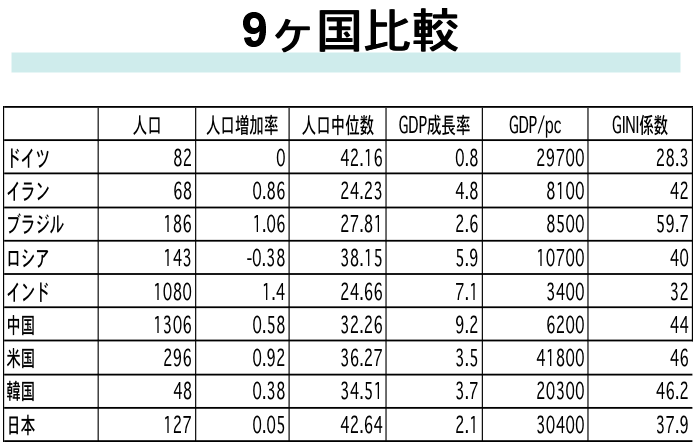
>Top 11. Fundamentals of nine countries:
- 9 typical countries are selected to compare the basic statistics,
including US, Germany, Japan & Korea, and BRICs.
- Population is in million.
- Population growth is in %.
- Median of population is age. Japan and Germany are typically aged
society.
- GDP growth is in %
- GDP per capita (PPP) is in US$.
- GINI index is the same with the former map. But it is conspicuous
that US shows as much as 46.2, which means economic divide: the
rich becomes richer, the poor becomes poorer.
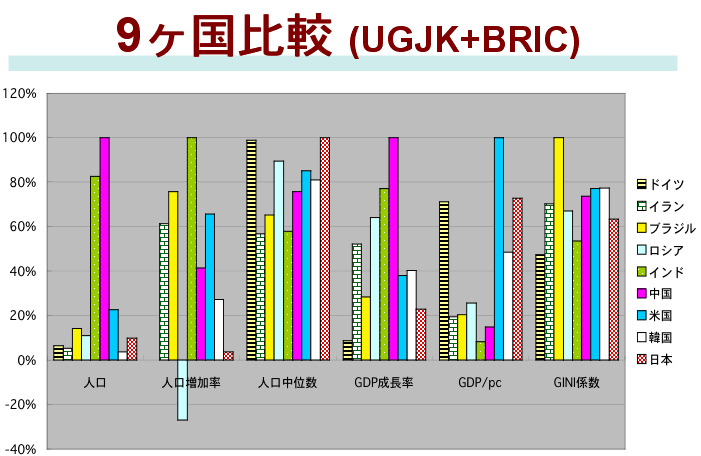
>Top 12. Relative comparison of nine countries:
- This is relative graph of the former data. Each country has relative
bar graph compared to the top ranking nation (100%).
- The demographic imbalance is remarkable: China and India. Population
of India is still growing very rapidly.
- Median age show how Japan and Germany are elder societies.
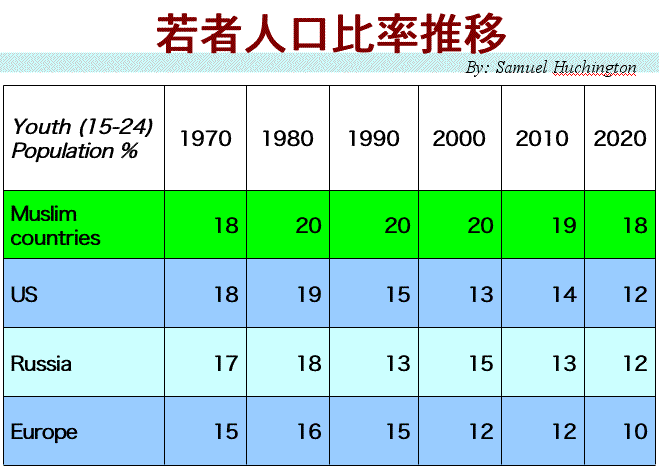
>Top 13. Ratio of youth population:
- In 1970s and 80s there was not a big difference of ratio of youth
population (15-24 years)
- Muslim countries with high growth of birth rate are estimated
to maintain relatively higher ratio of youth population.
- Other regions tend to decrease youth ratio.
- Thus various unsolved social problems in most of muslim countries
may be related to this higher ratio of youth ratio.
- Because youth need more food, new habitation, stronger interest
for the future, and more direct response of moral sense, etc.
- Even in Japan, when the baby-boomers were students, radial social
protest movements were active.
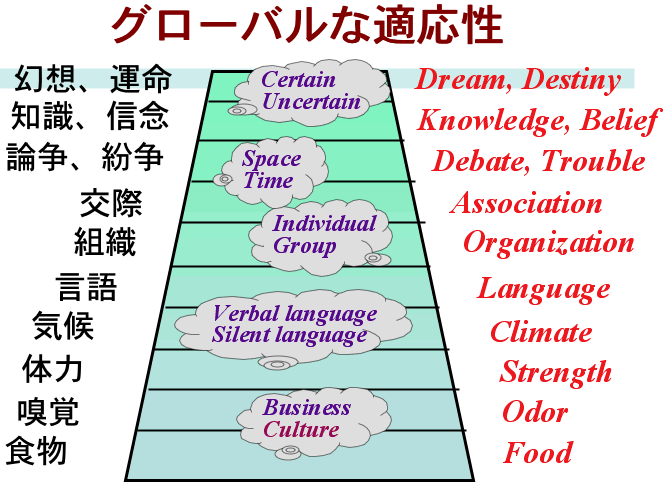
>Top 14. Global adaptability:
- Here is a vaulting box of 10 layers showing adaptability of foreign
cultures.
- For a japanese, Japanese food is the best, but we must familiarize
local food if we want stay long there.
- The lower layers mostly composed of physical barriers, while the
upper more mental ones.
- In order to communicate, debate or dispute people of different
culture, we must be more flexible and more patient to overcome cultural
difference.
- Challenging sprit is always urged in jumping vaulting box and
being global.
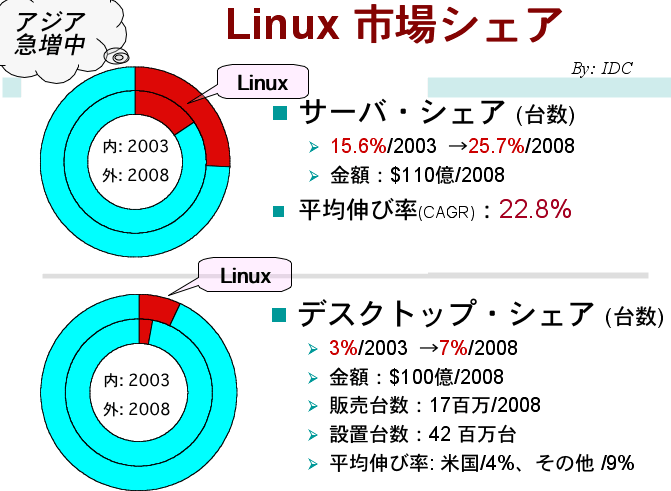
>Top 15. Linux market share:
- At NEC Soft, I am involved in various Linux related activities
such as OSDL-Japan.
- In 2005 I visited Vietnam 5 times to make survey eGov & OSS
situation in Vietnam.
- METI is promoting to proliferate OSS technological transfer to
Asian countries, cooperating with C-J-K.
- Linux server is growing very rapidly with more then 20% (CAGR)
- Even Linux desktop is growing steadily.
- Piracy problem is one of the motivation of migrating into Linux
system as well as TCO reduction.
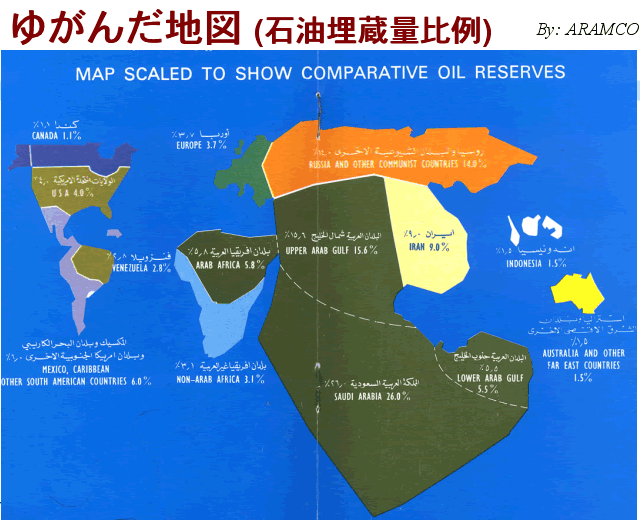
>Top 16. Distorted
map:
- I encountered this distorted map in a pamphlet of ARAMCO in 1979
when I stayed in Saudi Arabia.
- This map is described according to comparative oil reserves.
- Unfortunately, we couldn't find Japan on this map.
- The confidence of people of oil producing countries is reflected
on this distorted map, like Arabian continent rather than peninsula.
- Let's try to describe another distorted map comparable creativity,
affluence of ideas, skillfulness of manufacturing, or faithfulness
of peace-loving mind, etc.
- Every nation, every tribe, every company, or everybody has its
own distorted map according to respective interest.
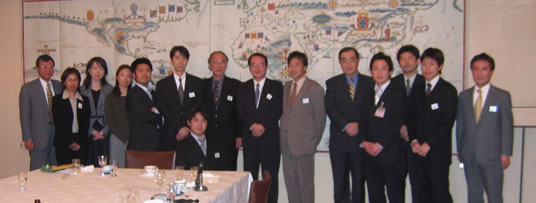
- >Top
- There is another distorted map made in 17C by Europeans at 22F
reception hall of Itochu building.
- This is also another reality and recognition of the world at that
time.
Comment
- Thank you for Mr. H. Miyamoto who arranged everything giving me such
a wonderful opportunity. I swear to continue further efforts to
find more fact and understanding.
- このような素晴らしい機会を与えるべくすべてを準備してくれた宮本博氏に感謝したい。これからもさらなる事実と理解のための努力を続けたい。
Title |
The last presentation for NEC Soft Ltd. |
NECソフト向け最後のプレゼンテーション |
|---|---|---|
Index |
|
|
Why? |
|
|
Presentation |
Message |
 |
>Top 0. Globalism in the Information Age:
|
 |
>Top 1. Index:
|
 |
>Top 2. My career and background:
|
 |
>Top 3. What is global?:
|
>Top 4. Various universes:
|
 |
>Top 5. Diachronic (historical) viewpoint:
|
 |
>Top 6. Synchronic viewpoint:
|
 |
>Top 7. Recent network theory:
|
 |
>Top 8. Value of network:
|
 |
>Top 9. Clash of the civilizations:
|
 |
>Top 10. GINI index:
|
 |
>Top 11. Fundamentals of nine countries:
|
 |
>Top 12. Relative comparison of nine countries:
|
 |
>Top 13. Ratio of youth population:
|
 |
>Top 14. Global adaptability:
|
 |
>Top 15. Linux market share:
|
>Top 16. Distorted map:
|
|
Comment |
|
|